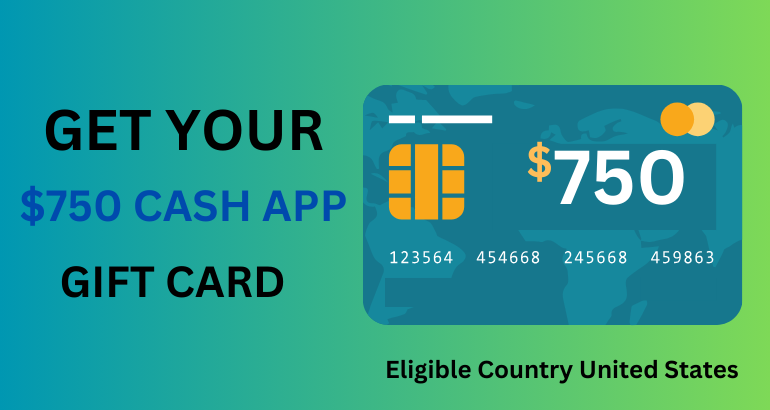Get Your $750 Cash App Gift Card
Users can send money to one another using a mobile phone app through Cash App, formerly known as Square Cash, a mobile payment service that is accessible in the US and the UK.[1] By 2024, the service will have 57 million monthly active users and generate US$14.7 billion in revenue annually.[2][3]
Peer-to-peer transactions, direct deposits, debit cards, savings accounts, investing in Bitcoin and stocks, tax filing services, and personal loans are all provided by Cash App.[6]
History
Cash App was introduced as "Square Cash" on October 15, 2013,[7] by Block, Inc. (formerly known as Square, Inc. at launch).
Square launched Square Cash for businesses in March 2015. This made it possible for people, groups, and entrepreneurs to establish a special username—known as a $cashtag—for sending and receiving money. Since then, the $cashtag has emerged as the most widely used money transfer mechanism among users.[8][9]
Cash App introduced functionality for bitcoin trading in January 2018.[10][11][12]
Cash App started supporting stock trading for US consumers in October 2019.[Square said in November 2020 that it will be integrating Credit Karma Tax, a free self-filing tax service, into its Cash App division for a $50 million purchase.[14]
The service recorded 57 million monthly active user accounts in 2024, with yearly revenue of US$14.7 billion.[2][3]
Services
Banking
While international transactions were not initially supported, users can send, receive, and store money within the United States and the United Kingdom.[1][15] Users of the Cash App can move money to a bank account within their nation. With the Cash Card, consumers can spend their money at different stores and get cash out of an ATM. It is a debit card that can be customized.[16][17][18] Users can personalize their Cash Card upon registration by choosing a color, writing on it, adding stamps, and even making it glow in the dark. The user receives the card with the finished design via mail.[19]
Automated clearing house (ACH) direct deposits are supported by the Cash App as of March 7, 2018.[16][20] Cash App allows for cash deposits as well. It's named
Paper Money Deposits: Depending on the merchant, a fee of $1 or more may be charged. Cash is brought to a participating retailer, who scans a barcode to deposit the money with Cash App.[21]
Transferring money between peers
It is possible for users to send and receive money between Cash App accounts by email, phone number, or $cashtag[22] (or £cashtag for accounts located in the UK). Users have the option to provide a message to be delivered to the counterparty when sending money.[23] When transferring funds into a third-party bank account, Cash App offers two options: instantaneous with a 1.5% cost, or free for five business days.
Only $250 weekly and $1,000 monthly can be sent and received from unverified accounts. A user's legal name, birthdate, and, in the case of US users, the final four digits of their social security number must be submitted in order to validate their account. Verification eliminates the receiving cap and increases the weekly sending maximum to $7,500.[24]
The cryptocurrency
In 2018, the app was updated to include the feature of buying and selling bitcoin cryptocurrency, exclusively for adult users [10].[25] Additionally, users can withdraw their bitcoin to an external wallet, deposit bitcoin into the app from another source, and send bitcoin to each other using their $cashtag. Purchasing and selling bitcoin on Cash App is instantaneous and does not require blockchain confirmation, in contrast to other cryptocurrency exchanges. The only cryptocurrency that Cash App supported as of 2023 was bitcoin.[26]Making Investments
Individual loans
It was revealed in October 2023 that a portion of users could borrow up to $200 with the Cash App.[6]filing taxes
Square purchased Credit Karma's tax preparation business in November 2020 and merged it into Cash App as Cash App Taxes.[28] As it was prior to the acquisition, the business provides online tax filing for customers in the US and is free to use. USA Today ranked it "best overall" in March 2023, however they pointed out that it wasn't suitable for "every tax situation".[5]Finances:
The Business model
Cash App is available for free download on Google Play for Android smartphones and the Apple App shop for iOS devices, among other mobile shop platforms. The software encourages more users to register and use its services because it is originally free. Extra services beyond the typical money transfer can be had for a small upfront set charge plus percentage fees.[30]
The main source of revenue for Cash App is when customers transfer money to their associated bank accounts via the app. Within five business days, money can be moved into a third-party bank account fee-free, or promptly for a 1.5% fee.[31]Users will be charged $2 when they withdraw money from an ATM if they do not have a direct deposit account with the app. For a minor service charge based on the volatility of the current bitcoin market, Cash App customers can purchase and sell bitcoin directly from their platform. Additionally, companies who accept Cash App as payment may impose a 2.75 percent transaction fee.
Cash App can create money by lending user deposits to different institutions and charging interest, just like banks can. In accordance with fractional-reserve banking, Cash App must retain 10% of users' account liquidity in order to safeguard depositors in the case of a bank run.





No comments: